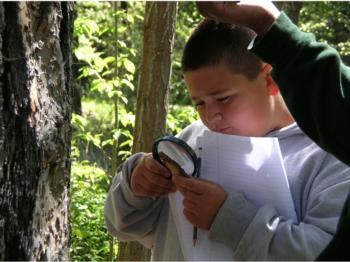4-H Delivers
Teens Teach Science and Stewardship
The Issue

Many children today—particularly those from urban, economically disadvantaged communities—do not have opportunities to investigate and experience the natural world. These children are the stewards of the environmental health of the planet, and they need an understanding of ecological principles and life sciences, and the chance to discover the workings of nature.
Additionally, engaging youth in meaningful service opportunities leads to greater community involvement. Young people grow up to appreciate their responsibility as citizens and their role in problem solving and contributing to community well-being.
What has 4-H Done?
The 4-H On the Wild Side project brought environmental education and outdoor living experiences to elementary school students from Sacramento’s economically challenged neighborhoods. The collaborative project—uniting 4-H, local universities, community organizations, after school programs and elementary schools—fostered learning, engaged teenagers in authentic leadership, and developed enthusiasm for the outdoors in children and teens. Trained teenagers worked in partnership with adults to plan and deliver all aspects of the program including two overnight camping experiences in Nevada City for 140 4th-6th grade students.
As part of their training, teenagers and volunteers learned how to build science skills when delivering their lessons. Children attending On the Wild Side didn’t just learn about science, they became scientist themselves as they investigated trees, explored habitat, and tested the water in the lake.
The Payoff:
Both quantitative and qualitative data point to a rich learning experience for the elementary students and teens participating in On the Wild Side. Pre- and post-tests reveal that the elementary school students gain knowledge about the environmental concepts presented through the program (p=.00), and the children's journal entries confirm that learning that takes place. Moreover, almost everyone rated their experience at camp as either good or excellent.
Of the young people who staffed the weekend program, 94% (16 of 17) indicated that they felt they made an important contribution to the community through the project.
Quotes:
“This year being part of On the Wild Side has made my love for working with kids grow stronger and it made me more confident in the abilities I have.” --Teen Teacher
“I felt comfortable with (the adults) and was able to work well with them. Overall I felt we had a good, productive relationship that helped the program (be) more successful.” --Teen Teacher
“I got to look at the stars. I saw the Big Dipper, the Little Dipper, and the Milky Way. It looked like a line of milk and glitter.” --Camper
By Marianne Bird, 4-H Youth Development Advisor, Sacramento County



